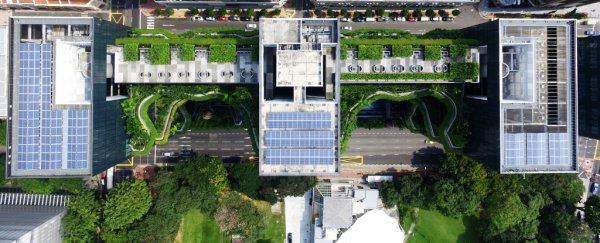If the United Kingdom put aside even a small fraction of its urban land to grow fruit and vegetables, it could quadruple the amount of food the nation produces from current horticulture, according to new research.
Using the city of Sheffield as a case study, researchers showed that if just 10 percent of this city's green spaces were reserved for farming, it could provide 15 percent of the local population with their 'daily five'.
"At the moment, the UK is utterly dependent on complex international supply chains for the vast majority of our fruit and half of our veg – but our research suggests there is more than enough space to grow what we need on our doorsteps," says ecologist Jill Edmondson from the University of Sheffield.
"Even farming a small percentage of available land could transform the health of urban populations, enhance a city's environment, and help build a more resilient food system."
This untapped potential was found by using a geographic information system (GIS) to map green infrastructure in the city, such as parks, gardens, roadside verges and woodland, as well as grey infrastructure, like buildings and roads.
Once these spaces were identified, the team developed a conceptual framework to address what practical factors and limitations were at play for each location, whether they be scientific, structural, or sociocultural.
The crops the authors considered could either be planted in soil or on flat roofs. While the latter may not sound like a great place to make a garden, for fruit like tomatoes, it could be extremely useful.
Today, the UK imports 86 percent of its total tomato supply, but if just 10 percent of the flat roofs in the middle of Sheffield became soil-free tomato farms, it could grow enough food to put 2 percent of the UK population on their way to a 'five a day' diet – a figure that jumps to 12 percent if three quarters of the roofs become used.
Allotted land used specifically for horticulture in Sheffield currently comprises only 1.3 percent of green infrastructure, with a further 38 percent as domestic gardens.
Sheffield has the sixth largest population in England and Wales, but nutritionally, it is among the most deprived – so much so, the authors think food insecurity will likely be an issue in the future.
The new research, however, suggests there's plenty of room for improvement. The city still has an additional 11 percent of green infrastructure that could be useful for commercial growing, and 4 percent that could be good for community garden-style growing.
Together, the authors predict that's nearly a 100-metre-square garden per person. If 100 percent of that space was used, it could feed roughly 709,000 people their daily five per year, which is greater than the entire population of Sheffield.
"This is an upper estimate," the authors warn, "given that not all identified land would be usable in practice, and cultivation of smaller parcels (such as domestic gardens) may be subject to disproportionate losses to infrastructure (access, storage)."
Nevertheless, they argue, putting even less than a quarter of that space to use would equal the UK's current commercial production of fruits and vegetables.
More realistically, if gardening was practised in a tenth of those domestic gardens and expanded into 10 percent of the additional land identified, it could feed 12 percent of Sheffield's population per year. When the allotted land already in use is also included, that reaches 15 percent or 87,375 people.
With less than 20 percent of fruit and around half of all vegetables sold in the UK grown domestically, this type of management could help secure the nation's food security.
The nation has done stuff like this in the past, although never on such a large scale. In 2015, for instance, London began the world's first underground urban farm in an old bomb shelter, and in recent years, rooftop gardens have become far more popular in this densely-populated city.
"It will take significant cultural and social change to achieve the enormous growing potential of our cities – and it's crucial that authorities work closely with communities to find the right balance between green space and horticulture," says Duncan Cameron, director of the Institute for Sustainable Food at the University of Sheffield.
"But with careful management of green spaces and the use of technology to create distribution networks, we could see the rise of 'smart food cities', where local growers can support their communities with fresh, sustainable food."
The study was published in Nature Food.
